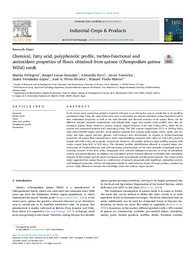Por favor, use este identificador para citar o enlazar este ítem:
https://hdl.handle.net/11000/30569Registro completo de metadatos
| Campo DC | Valor | Lengua/Idioma |
|---|---|---|
| dc.contributor.author | Pellegrinia, Marika | - |
| dc.contributor.author | Lucas-Gonzales, Raquel | - |
| dc.contributor.author | Riccia, Antonella | - |
| dc.contributor.author | FONTECHA, JAVIER | - |
| dc.contributor.author | Fernandez-Lopez, Juana | - |
| dc.contributor.author | Pérez-Álvarez, José A. | - |
| dc.contributor.author | Viuda-Martos, Manuel | - |
| dc.contributor.other | Departamentos de la UMH::Tecnología Agroalimentaria | es_ES |
| dc.date.accessioned | 2024-01-23T11:40:34Z | - |
| dc.date.available | 2024-01-23T11:40:34Z | - |
| dc.date.created | 2017-10 | - |
| dc.identifier.citation | Industrial Crops and Products Volume 111, January 2018 | es_ES |
| dc.identifier.issn | 1872-633X | - |
| dc.identifier.issn | 0926-6690 | - |
| dc.identifier.uri | https://hdl.handle.net/11000/30569 | - |
| dc.description.abstract | In the recent years, quinoa has gained a renewed relevance as an alternative crop to cereals due to its excellent nutritional value. Thus, the aims of this work were to determine the physico-chemical, techno-functional and in vitro antioxidant properties as well as the total phenolic and flavonid contents of six quinoa flours. On the different samples proximal compositions and polyphenolic, sugar and organic acids profiles were also determined. Quinoa flours showed a protein content ranged between 11.62 and 13.66 g/100 g while the fat content was comprised between 4.87 and 6.48 g/100 g. The TDF content ranged from 12.71 to 18.59 g/100 g with ratios IDF:SDF higher than 8:1. In all samples analyzed four organic acids (oxalic, ciltric, malic, and succinic) and three sugars (sucrose, glucose, and fructose) were determined. As regards to techno-functional propreties, all quinoa flours showed lower water and oil holding capacities with values of 1.44–1.80 g water/g sample and 0.89–1.04 g oil/g sample, respectively. However, all samples showed a high swelling capacity with values ranged from 8.55 to 9.57 mL/g. The chemical profiles identification allowed to exposed major concentrations of 4-hydroxibenzoic acid and interesting concentrations of the other phenolic compounds and interesting contents of Ω3 fatty acids, compounds with renewed biological properties in terms of antioxidant activity and control diseases. In addition, the antioxidant activity assessed allowed to establish their antioxidant capacity of this product and the good correlations with total phenolic and flavonoid contents. The results of this study suggested that quinoa flours is a valid source of natural compounds with significant antioxidant activity and biological properties. Further investigations should be undertaken in respect of target product, anyhow the present study allowed to increase the knowledge about this Andean region species | es_ES |
| dc.format | application/pdf | es_ES |
| dc.format.extent | 9 | es_ES |
| dc.language.iso | eng | es_ES |
| dc.publisher | Elsevier | es_ES |
| dc.rights | info:eu-repo/semantics/openAccess | es_ES |
| dc.rights | Attribution-NonCommercial-NoDerivatives 4.0 Internacional | * |
| dc.rights.uri | http://creativecommons.org/licenses/by-nc-nd/4.0/ | * |
| dc.subject | Quinoa seeds | es_ES |
| dc.subject | Flours | es_ES |
| dc.subject | Fatty acids profiles | es_ES |
| dc.subject | Polyphenolic profile | es_ES |
| dc.subject | Antioxidant | es_ES |
| dc.subject.other | CDU::6 - Ciencias aplicadas::62 - Ingeniería. Tecnología | es_ES |
| dc.title | Chemical, fatty acid, polyphenolic profile, techno-functional and antioxidant properties of flours obtained from quinoa (Chenopodium quinoa Willd) seeds | es_ES |
| dc.type | info:eu-repo/semantics/article | es_ES |
| dc.relation.publisherversion | http://dx.doi.org/10.1016/j.indcrop.2017.10.006 | es_ES |

Ver/Abrir:
Chemical, fatty acid, polyphenolic profile, techono.....pdf
282,4 kB
Adobe PDF
Compartir:
 La licencia se describe como: Atribución-NonComercial-NoDerivada 4.0 Internacional.
La licencia se describe como: Atribución-NonComercial-NoDerivada 4.0 Internacional.
.png)